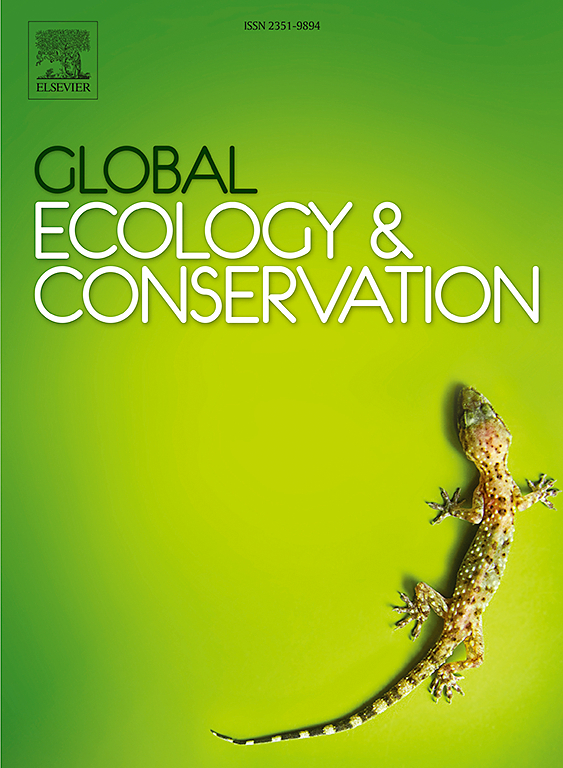台湾青屿地蟹繁殖期,利用创新指引设施减低道路撞死率
IF 3.5
2区 环境科学与生态学
Q1 BIODIVERSITY CONSERVATION
引用次数: 0
摘要
在2022年5 - 9月和2023年5 - 9月的繁殖季节,在台湾绿岛西侧石郎至贵班环城公路沿线的道路死亡热点对地蟹和寄居蟹(以下简称地蟹)进行了研究。利用公路下连接山侧和海侧的两组涵洞设置引导设施,引导地蟹进入涵洞安全过马路,将幼蟹放归大海。本研究旨在评估这些引导设施在降低陆蟹道路死亡率方面的有效性。该研究分为对照组和实验组,共包括54项调查,其中29项在2022年进行,25项在2023年进行。调查在早上进行了26次,在晚上进行了28次。共记录到9种地蟹,以长尾蟹(Metasesarma aubryi)数量最多,其次为短尾蟹(Coenobita brevimanus)。2023年记录的个体总数为1258只,显著高于2022年的575只,其中6月、7月、8月和9月为高峰。诱导设施对奥布氏芽胞杆菌的利用率显著高于对照组(P = 0.005),对brevimanus的利用率也显著高于对照组(P = 0.038)。2022年,实验组的总体道路死亡率为8.5 %,而对照组为26.8 %。同样,在2023年,对照组的路杀率为32.1% %,而实验组仅为12.1% %。2022年和2023年,对照组的道路致死率分别为41.7 %和45.8 %,而试验组的道路致死率分别为19.4 %和22.8 % (P = 0.001)。2022年和2023年,对照组布雷维曼弧菌的路杀率分别为4.5 %和4.3 %,实验组的路杀率分别为0.9 %和0.4 %,实验组的路杀率显著低于对照组(P = 0.024)。因此,在2022年和2023年,实验组的路杀率都比对照组降低了一半以上,说明所实施的引导改进措施是有效的。基于这些发现,未来的设计可以包括在其他道路死亡热点地区安装类似的地下涵洞和引导设施,以大大减少陆地蟹的道路死亡率。本文章由计算机程序翻译,如有差异,请以英文原文为准。
Using innovative guidance facilities to reduce roadkill rates during land crab breeding season in Green Island, Taiwan
During the breeding seasons from May to September of 2022 and 2023, a study on land crabs and hermit crabs (hereinafter referred to as land crabs) was conducted in a roadkill hotspot located along the circular road from Shilang to Guiban on the west side of Green Island, Taiwan. Two sets of culverts connecting the mountain side to the sea side under the road were utilized to install guidance facilities, directing land crabs into the culverts to safely cross the road and release their juveniles by the sea. The study aimed to evaluate the effectiveness of these guidance facilities in reducing land crab roadkill rates. The study was divided into control and experimental groups, comprising a total of 54 surveys, with 29 conducted in 2022 and 25 in 2023. Surveys were carried out 26 times in the morning and 28 times at night. A total of nine species of land crabs were recorded, with the highest numbers observed for Metasesarma aubryi, followed by Coenobita brevimanus. The total number of recorded individuals in 2023 was 1258, significantly higher than the 575 recorded in 2022, with peak numbers observed in June, July, August, and September. The utilization rate of the guidance facilities for M. aubryi was significantly higher than that of the control group (P = 0.005), and similarly, the utilization rate for C. brevimanus was significantly higher than the control group (P = 0.038).
In 2022, the overall roadkill rate for the experimental group was 8.5 %, compared to 26.8 % for the control group. Similarly, in 2023, the roadkill rate for the control group was 32.1 %, while the experimental group was only 12.1 %. For M. aubryi, the road kill rate in the control group was 41.7 % in 2022 and 45.8 % in 2023, while the experimental group had rates of only 19.4 % and 22.8 %, respectively (P = 0.001). For C. brevimanus, the roadkill rates for the control group in 2022 and 2023 were 4.5 % and 4.3 %, while the experimental group had rates of 0.9 % and 0.4 %, indicating that the experimental group had significantly lower roadkill rates than the control group (P = 0.024). Therefore, in both 2022 and 2023, the experimental group had a roadkill rate reduced by more than half compared to the control group, demonstrating the effectiveness of the guidance improvement measures implemented. Based on these findings, future designs could involve the installation of similar underground culverts and guidance facilities in other road kill hotspots to greatly reduce land crab roadkill rates.
求助全文
通过发布文献求助,成功后即可免费获取论文全文。
去求助
来源期刊

Global Ecology and Conservation
Agricultural and Biological Sciences-Ecology, Evolution, Behavior and Systematics
CiteScore
8.10
自引率
5.00%
发文量
346
审稿时长
83 days
期刊介绍:
Global Ecology and Conservation is a peer-reviewed, open-access journal covering all sub-disciplines of ecological and conservation science: from theory to practice, from molecules to ecosystems, from regional to global. The fields covered include: organismal, population, community, and ecosystem ecology; physiological, evolutionary, and behavioral ecology; and conservation science.
 求助内容:
求助内容: 应助结果提醒方式:
应助结果提醒方式:


